Trucker Access › Forums › Diesel News › Meet HDT’s 2022 Top Green Fleets – Fuel Smarts
- This topic has 0 replies, 1 voice, and was last updated 11 months ago by
 EazyRiDer66.
EazyRiDer66.
-
AuthorPosts
-
May 18, 2024 at 9:45 am #21005
 EazyRiDer66Keymaster
EazyRiDer66Keymaster

HDT’s 2022 Top Green Fleets all share a commitment to sustainability and the environment.
HDT’s 2022 Top Green Fleets have sustainability strategies as varied as the fleets themselves. This year’s honorees include new companies and those that are generations old. Fleet size ranges from 50 trucks to more than 18,000. Operations include truckload, less-than-truckload, government, private fleets, oil-field, drayage, postal contractors, and more.
You might expect green fleets to cluster in states where there are a lot of regulatory and financial incentives, and indeed a number of our honorees have operations in California. But they’re also in the Carolinas, Massachusetts, Ohio, Texas, Arizona, Kentucky, Michigan, Illinois, Pennsylvania, and Nebraska.
The tactics taken are a broad variety, as well — often in the same fleet. Most of our honorees are at least investigating or testing battery-electric trucks, and some are already operating and ordering dozens. A few are looking at hydrogen-fuel cell electric. Natural gas, renewable natural gas, biodiesel, renewable diesel, electric hybrids are all on the table. Solar panels help power fleet facilities. Some are pushing the envelope in mpg, and some are more focused on freight efficiency — moving the most freight with the smallest number of trucks, miles, and fuel.
We are seeing more Top Green Fleet nominees that are putting out sustainability reports and setting goals for their programs. Many calculate how much in carbon dioxide has been prevented from going into the atmosphere thanks to changes they’ve made. Some mention Scope 1 and Scope 2 emissions and how they’re helping their customers reduce their carbon footprint.
Whatever their path, HDT’s Top Green Fleets all share a commitment to sustainability and the environment.
How the Top Green Fleets are Chosen
Each year, we put out a call for nominations and fleet submissions to be considered for HDT’s Top Green Fleets. Our editors comb through those submissions and evaluate a number of factors in making their decision, including:
- Adoption of alternative fuels and drivetrains
- Industry-leading fuel economy
- Freight-efficiency strategies
- Leading-edge “green” facilities
- Sustainability goals
- Recent progress in sustainability journey
- Willingness to share their experience with others
- Other “green” awards received
- Plans for the coming year
In the past, we have supplemented the nominations and submissions received with additional fleets we felt deserved recognition even if they didn’t officially enter. However, the number of fleets implementing electric trucks, alternative fuels, and other sustainability strategies has become too great to do this. This year and going forward, Top Green Fleets are being chosen only from the nominations and submissions received. (Our 2023 awards will open for nominations in late February and be published in our annual June fuel issue.)
On the following pages, meet 20 of the fleets leading the green revolution in the U.S. trucking industry. And keep an eye out for our three-part webinar series in 2022, The Road to Zero Emissions, which will feature some of our Top Green Fleets as panelists.
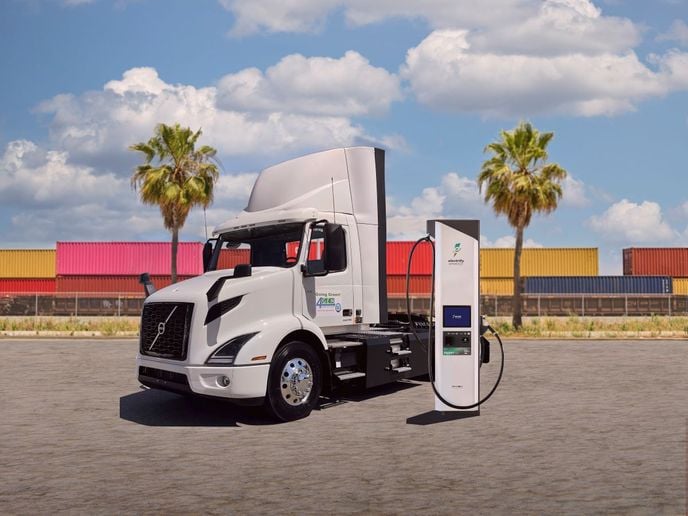
4 Gen Logistics’ Volvo VNR Electric trucks operate two shifts per day, making up to six runs to and from the Port of Long Beach and the company’s headquarters in Rialto, California.
4 Gen Logistics – Rialto, California
4 Gen Logistics, a fourth-generation, family-owned drayage company, has a goal of operating a 100% zero-tailpipe emission fleet by 2025. It currently has 50 heavy-duty vehicles but is growing fast. With six Class 8 battery-electric trucks already in operation, 4 Gen has ordered and is starting to receive an additional 61, all to be delivered in 2023. In the meantime, it also is using renewable natural gas. Plans are to have 90 charging stations built by the end of 2023.
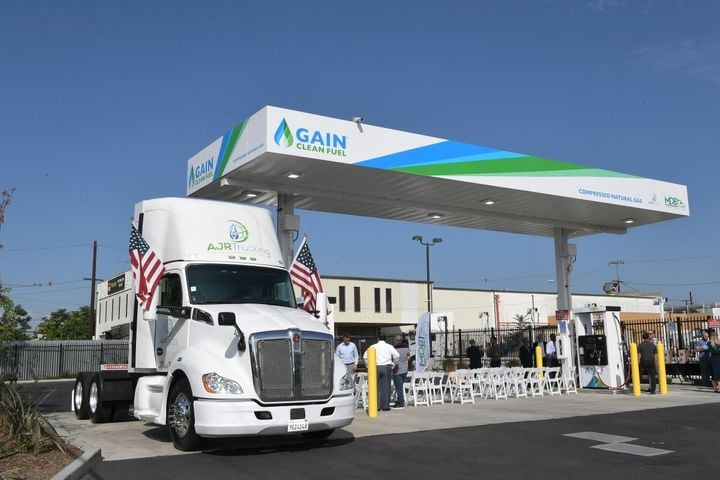
AJR Trucking’s commitment to reducing emissions is demonstrated by the fact that it began bidding on postal contracts using trucks powered by renewable natural gas before those trucks had truly hit the market.
AJR Trucking – Compton, California
AJR is a for-hire regional and long-haul contractor for the U.S. Postal Service. Its commitment to sustainability started in 2017 with its first near-zero natural gas truck fueled by renewable natural gas. Today, out of its 327 heavy-duty trucks, three are battery-electric and 115 are powered by RNG. AJR invested in its own fueling station in 2021, allowing it to more quickly grow its own green fleet as well as offer access to RNG to other fleets. In February, AJR ordered 15 battery-electric Class 8 tractors and 10 Class 6 battery-electric trucks from Kenworth. It plans to replace another 40 diesel units with natural gas units in 2023. So far, AJR’s investments have eliminated 89,097 metric tons of greenhouse gas emissions from the atmosphere — the equivalent of 1.47 million trees planted and 19,245 cars removed from the road.
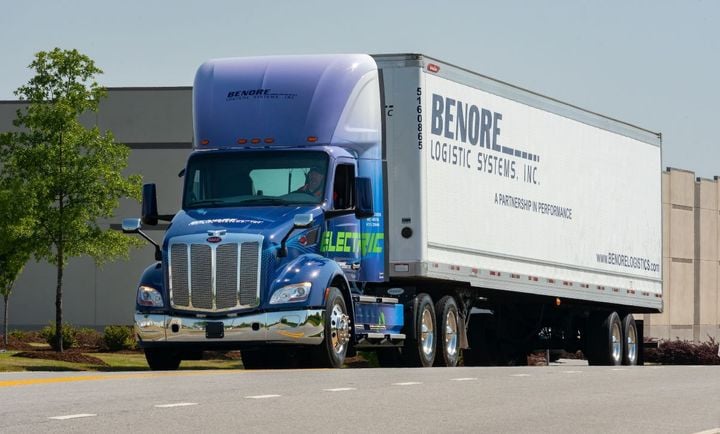
Benore took delivery of its first electric truck in April and was on track to have a total of eight by the end of the year.
Benore Logistics Systems – Greer, South Carolina
This for-hire regional and drayage fleet is “on an electrification and reduced carbon footprint journey.” When it took delivery of Peterbilt’s first battery-electric production Class 8 579EV, it also was the first electric truck in the state. Out of its 550 heavy-duty trucks, 2010 are 2021 model year diesels or newer, meeting GHG II emissions standards, and by replacing the fleet with newer fuel-efficient units, the company has increased its fuel mileage by 1.7 to 2 mpg. Three battery-electric trucks are already in service (Peterbilt and Nikola), with five more scheduled to arrive by the end of the year. The company is also studying electric terminal tractors and hybrid refrigeration technologies.
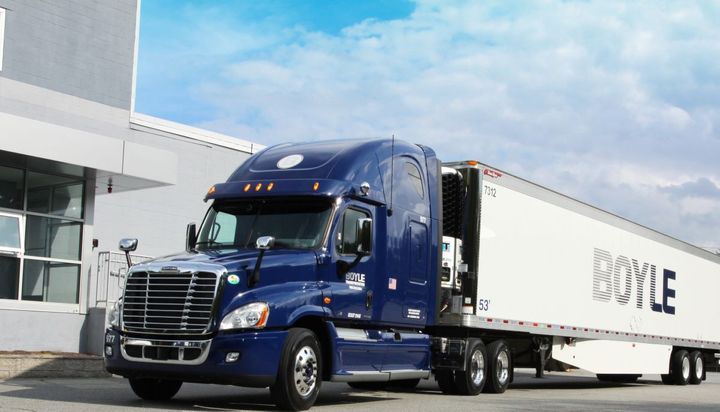
In spite of dramatically increasing the size of its fleet and workforce since 2015, Boyle Transportation has seen large drops in emissions and energy consumption.
Boyle Transportation – Billerica, Massachusetts
More than half of this long-haul for-hire carrier’s fleet of 91 heavy-duty trucks (55) are the latest-model clean diesels meeting GHG II emissions, with another 20 on order as it phases out older tractors. Boyle Transportation has invested heavily in optimization software for most efficient routing and planning, and it’s testing several idle reduction technologies, including solar panels for tractors. In 2021, Boyle was the first transportation company in North America to achieve ISO 14001 certification, which sets out the requirements for an environmental management system. This has led to the installation of solar panels at corporate headquarters, taking it nearly entirely off the grid. Boyle’s company-wide goal is to further reduce its energy consumption by 15% by the end of 2023.
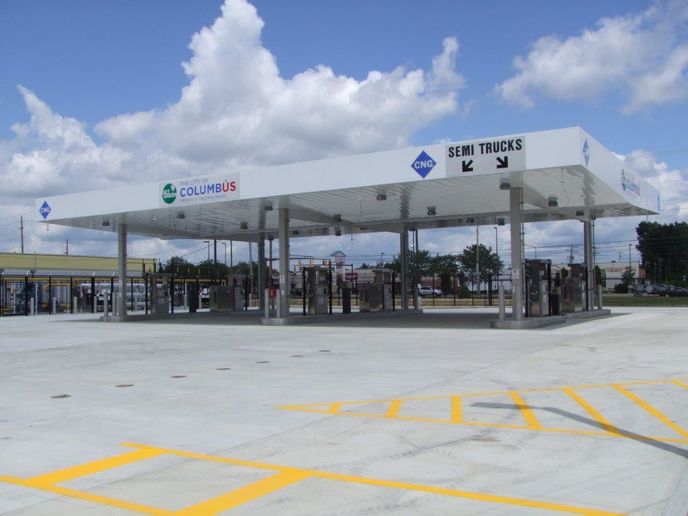
The City of Columbus has a target that at least 80% of heavy-duty purchases each budget year will be green, which has primarily meant natural gas engines.
City of Columbus Fleet Management Division – Columbus, Ohio
With nearly 500 heavy-duty vehicles and close to the same number of medium-duty, Columbus Fleet Management has a Green Fleet Action Plan that guides its sustainability efforts in conjunction with Columbus’ overall sustainability goals. The primary strategy has been to purchase natural-gas-powered vehicles whenever possible. It has purchased utility bucket trucks that use a hybrid hydraulic electric system that allows the bucket units to operate without the engine running. Going forward, it plans to electrify the fleet wherever possible as well as explore the use of renewable natural gas. It will be piloting an all-electric refuse truck in 2023. From 2013-2020, Columbus reduced its fleet emissions by over 33% — a CO2 reduction of more than 10,140 metric tons.
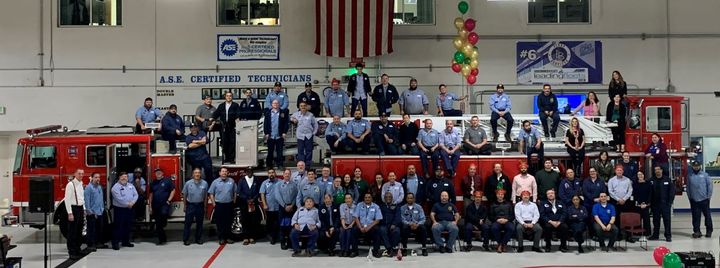
Out of 313 heavy-duty trucks in the City of Long Beach’s fleet, 126 are natural gas.
Photo: City of Long Beach
City of Long Beach – Long Beach, California
The Long Beach fleet’s primary strategy is aggressively adopting alternative-fuel vehicles. Its fleet of approximately 2,200 units uses renewable natural gas, renewable diesel, renewable propane, full electric, and hybrid vehicles. Out of 213 heavy-duty trucks, 126 are natural gas. Out of 180 medium-duty vehicles, 72 are natural gas, plus eight electric hybrids and two battery-electric. Solar panels installed on parking lot shade structures provide 25% of its buildings’ electric needs. Fleet Services and the Environmental Services Bureau are coordinating in 2022-2023 to purchase eight new refuse trucks to expand the city’s organics recycling program and are evaluating a demo of a 2022 Crane Carrier LNT EV Refuse truck. In addition, Fleet has created a dedicated position in the upcoming budget to assist with the growing scope of fleet electrification and infrastructure planning/implementation. Consultants have been hired to develop a blueprint for electrifying the medium/heavy-duty fleet.
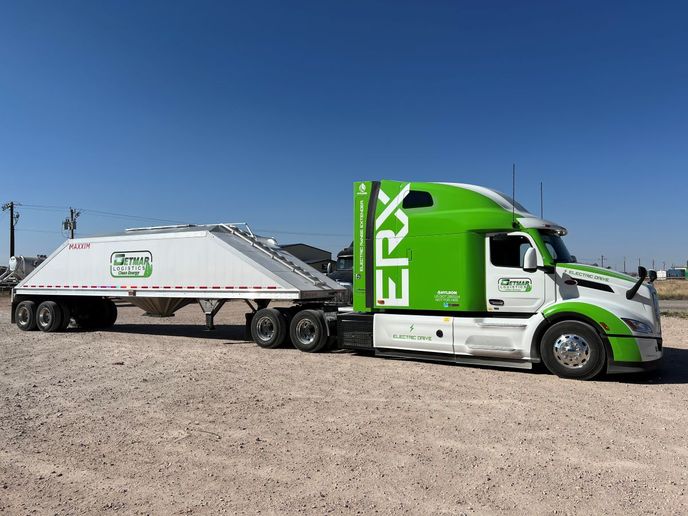
Hyliion has partnered with Detmar Logistics to electrify more than 100 trucks of its fleet over the next five years.
Detmar Logistics – San Antonio, Texas
Detmar Logistics has been a leader in the oil and gas sector for improving the fuel economy and reducing GHG emissions of its 150 heavy-duty trucks. It has been running Hyliion hybrid-electric trucks, currently with five in the fleet, and says they increased fuel economy by 8.2%. It also has five natural-gas trucks. The company is building a renewable natural gas station and has more RNG-hybrid electric trucks on order. It plans to convert the entire fleet to RNG.
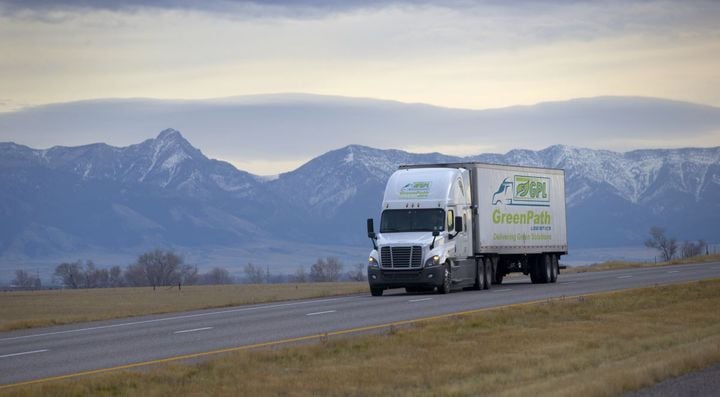
GreenPath Logistics says its alternative fuel fleet helps customers reduce carbon emissions by up to 85%.
GreenPath Logistics – Dallas, Texas
GreenPath Logistics, launched in 2020 as a subsidiary of NGV Global Group, uses no diesel fuel in its operations. Most of its 210 heavy-duty and 30 medium-duty trucks operate on renewable natural gas. It is also running hybrid-electric trucks, buying 50 Hyliion Hypertruck ERX units, and is testing all-electric and hydrogen Class 8 trucks by manufacturers such as Nikola, Ideonomics, and Westport. In the coming year, it plans the deployment of several other full-electric Class 8 trucks in port drayage and other applications.
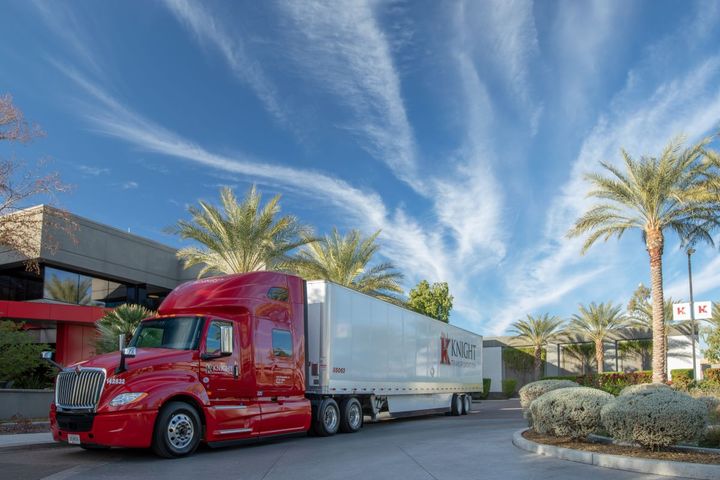
In 2020, Knight-Swift’s executive committee unanimously laid forth short and mid-term emissions reduction goals that the company calls “aggressive and impactful.”
Photo: Knight-Swift Transportation
Knight-Swift Transportation – Phoenix, Arizona
Knight-Swift runs more than 18,700 heavy-duty vehicles. Of those, 100 are natural gas, 20 are battery-electric, and more than 2,800 are running on the latest clean diesels meeting GHG II emissions standards. In addition to buying new equipment to take advantage of improvements in efficiency, Knight-Swift is installing Start-Stop idle reduction technology. Small-scale testing of hydrogen fuel cell and battery-electric vehicles will occur throughout 2022. The company is part of a Department of Energy tractor electrification pilot program and will be operating 20 Class 8 tractors in California by the end of the year. Since March of 2021, the company has improved its score with numerous reporting entities, including CDP, DJSI, and Sustainalytics.
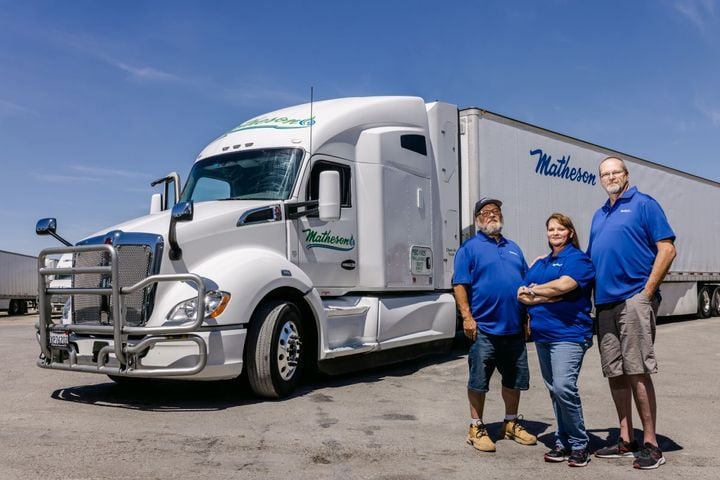
Matheson drivers from Salt Lake City with one of the company’s CNG trucks.
Matheson – Sacramento, California
Matheson has been committed to leaning into environmental fleet practices and alternative fuels since the 1990s. Nominated by the National Star Route Mail Contractors Association, the company was one of the first U.S. Postal Service contractors to adopt alternative fuels. Of its 195 heavy-duty vehicles, close to half (95) are powered by natural gas. It’s still had to buy diesel-powered trucks to operate in areas without an extensive natural-gas fueling infrastructure. Recently, Matheson partnered with Hyliion to test the viability of its electrified powertrain systems in long-haul transportation, particularly over challenging western terrain. “Matheson will be a cornerstone of the Postal Service’s ambitious Scope 3 emission reduction targets and the future of a sustainable Postal Service surface transportation network,” NSRMC said.
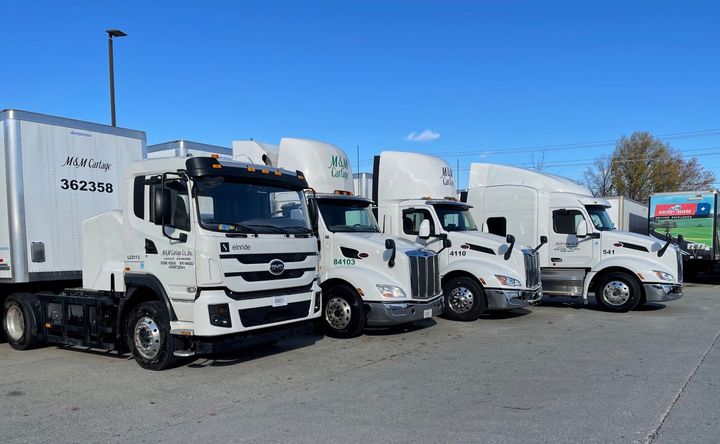
The M&M Cartage fleet now includes electric, along with renewable natural gas and diesel powered vehicles.
M&M Cartage – Louisville, Kentucky
Out of M&M’s 274 heavy-duty trucks, 112 are natural gas and two are electric. Pre-planning and maximum truck utilization help maximize freight efficiency and teaching drivers fuel-saving driving strategies helps improve fuel economy. M&M Cartage’s campus, completed in 2015, doubled the size and capacity of the previous facility while cutting Scope 2 emissions nearly in half. In partnership with Kentuckiana Clean Fuel, M&M operates CNG fuel stations in Louisville, Kentucky, and Sharonville, Ohio. Its latest initiative is incorporating battery-electric trucks into the fleet. The goal is to continue to develop and to deploy additional trucks on appropriate routes, while also phasing out old equipment and adding to its natural-gas fleet.
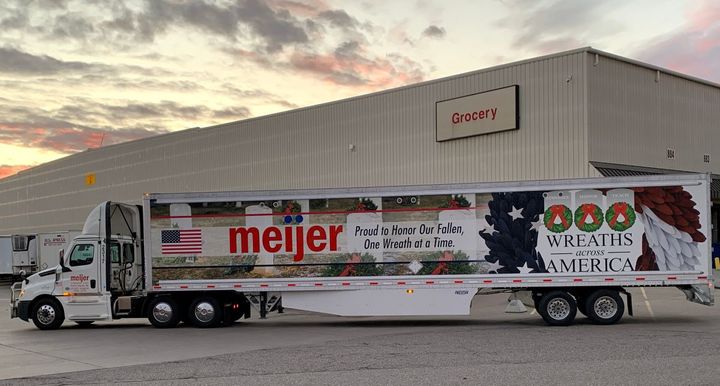
Meijer has decreased empty miles by over 4% and racks up impressive mpg numbers for a regional fleet.
Meijer Logistics – Lansing, Michigan
This regional private fleet operates 248 heavy-duty vehicles and regularly acts as a test fleet for OEMs. It will be the first fleet to take delivery of two Freightliner eCascadia tractors outside of California for cold-weather testing. Meijer will also be taking delivery of two Autocar electric yard tractors this year. It currently has two of the latest GHG II diesels, with delivery in the works of 38 more. In fuel mileage, Meijer averages 17% higher than its peer group in benchmarking, and that’s running up to 90,000 pounds gross vehicle weight. The fleet averages 7.61 mpg vs 6.5 mpg in its benchmarking group, and Meijer is currently operating at 8 mpg for the 2021 fiscal year with 126 of its Class 8 tractors.

NFI’s fleet of battery-electric tractors has achieved over 750,000+ miles of operation since launching in 2020.
NFI – Camden, New Jersey
NFI has long been a leading adopter of fuel efficiency specs and tactics and alternative fuels. A portion of its fuel is sourced from cleaner fuels such as biodiesel, electricity, propane, and compressed natural gas. NFI is a partner in the largest commercial deployments of battery-electric tractors in North America, working with vehicle manufacturers and infrastructure providers. Its fleet of battery-electric tractors (currently 41) has racked up more than 750,000 miles since launching in 2020. By 2023, NFI’s Southern California drayage fleet will become the nation’s first 100% zero-emission drayage fleet, adding 100 more battery-electric trucks to its operations. Also by 2023, it will have the first 100% zero-emission freight logistics facility in the United States, including zero-emission vehicles and onsite renewable electricity. NFI’s real estate team strives to build all new construction to meet LEED standards. Sustainability efforts in NFI’s 65 million square feet of warehousing/distribution operations include battery-powered forklifts, battery-powered automated units, and recycling programs, recycling over 250,000 pallets annually.
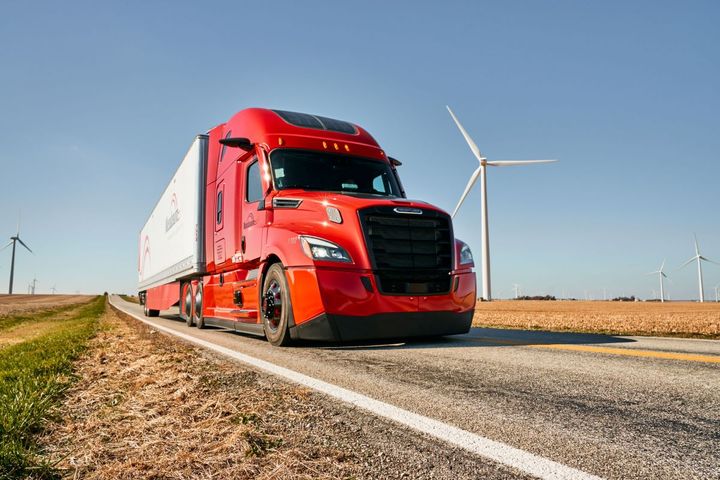
Lower gear ratios on trucks and fuel-efficient drivers have helped Nussbaum save 4,000 gallons of oil each year using extended oil drain intervals.
Nussbaum Transportation – Hudson, Illinois
Out of Nussbaum’s 551 heavy-duty trucks, 170 are the latest GHG II emissions diesels. For the previous 12 months, it achieved a fleetwide mpg of 9.10 and idle time percentage of 14%. It specs 6×2 and 6×4 trucks with low gear ratios to reduce rpms. Solar panels on 290 trucks charge Park Smart APUs to reduce idling (and increase battery life). Fuel-efficient specs include rear trailer flaps/trailer skirt system, aerodynamic mud flaps, hubcap covers, air dams, single-wide tires, offset wheels, 20-inch cab extenders, and automatic tire inflation systems. Its proprietary Driver Scorecard and Certified RED programs train and incentivize fuel-efficient driving habits. In the works, Nussbaum is testing 40-inch cab extenders (deploying at 55mph) and an idle reporting tool called Idle Smart. In 2023, its goal is an idle time of 10% or less.
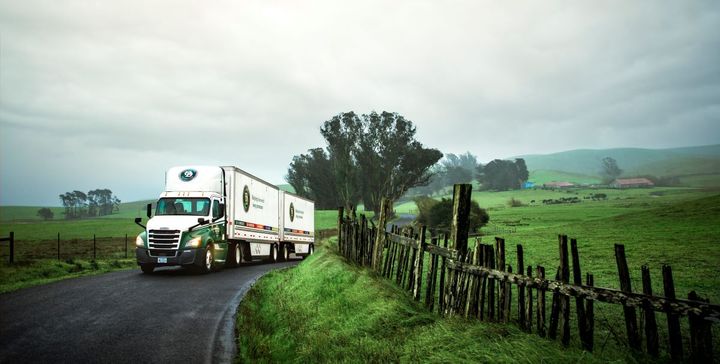
Old Dominion Freight Line uses twin 28-foot trailers and long combination vehicles where permitted to maximize freight efficiency.
Old Dominion Freight Line – Thomasville, North Carolina
Old Dominion Freight Line has just over 11,000 heavy-duty vehicles in its less-than-truckload fleet. It maximizes freight and fuel efficiency by strategically planning routes and maximizing use of trailer capacity with trailer deck bars and racking systems. Collaborating with manufacturers allows OD to tailor specs for their specific usage profile. The company took delivery of its first Volvo Class 8 electric truck, its first Autocar electric yard jockey, and five electric forklifts on its dock in Rialto, California. Low-carbon diesel accounts for approximately 20% of its total bulk fuel purchases and the company is working closely with renewable and biofuel distributors to expand its use, OD’s Scope 1 and Scope 2 emissions decreased by approximately 12% from 2018 to 2020.
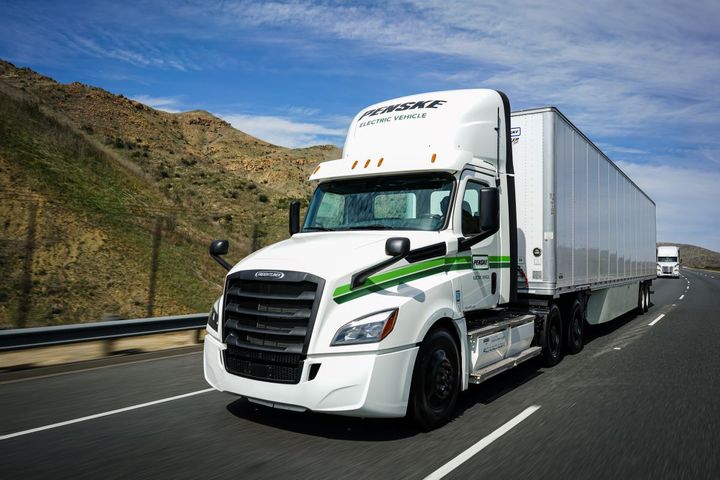
Penske Logistics teamed up with Daimler Truck North America to test the eCascadia battery-electric truck.
Penske Logistics – Reading, Pennsylvania
Out of Penske’s 9,904 heavy-duty vehicles, three are battery-electric and 2,112 have the latest GHG II clean diesels. It uses biodiesel and renewable diesel in some locations and operates another 678 medium-duty trucks. Penske and Daimler Truck North America formed a partnership to test Freightliner electric trucks in real-world situations. Penske is deploying these battery-electric vehicles in southern California, supported by a network of what it believes are the first heavy-duty, DC fast-charging stations at six Penske Truck Leasing facilities in Southern California. Penske is implementing numerous facility-level sustainable programs, such as renewable energy infrastructure, energy efficiency upgrades, and waste reduction policies.
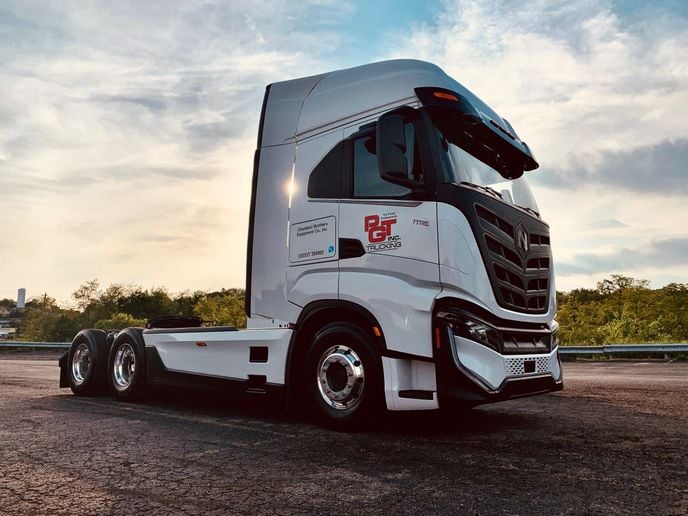
With a terminal in Phoenix, Arizona, PGT Trucking has an ideal location to use Nikola zero-emissions trucks.
PGT Trucking – Aliquippa, Pennsylvania
PGT operates both regional and long-haul with a fleet of 981 heavy-duty trucks. Its strategy to improve fuel economy and freight efficiency includes reducing empty/deadhead miles, monitoring drivers and equipment to ensure optimal performance, and integrating zero-emission vehicles and autonomous technology into the fleet. In 2023, PGT will begin receiving hydrogen fuel-cell electric trucks from Nikola at its Phoenix terminal, where it can take advantage of Nikola’s fueling stations in the West. PGT also will begin operating semi-autonomous truck convoys from Locomation next year. The company has identified the primary lanes that will benefit from this technology. PGT has set a carbon emissions goal to reduce the CO2 emissions of its company-owned fleet by 35% by 2025.
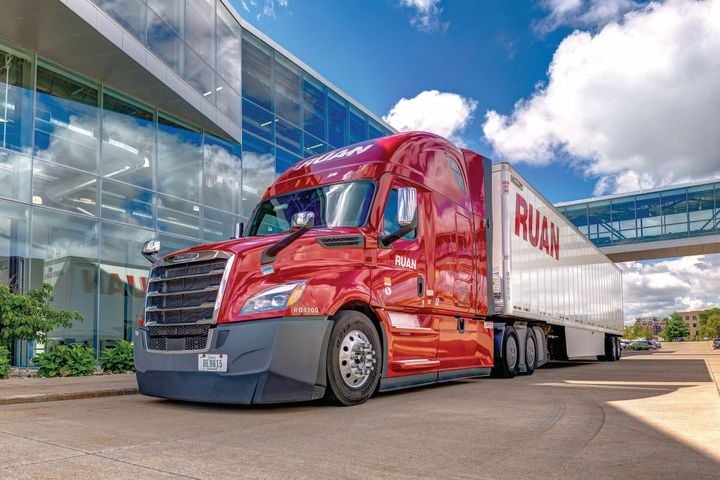
In addition to alternative-fueled and electric trucks, Ruan continues to test, study, and implement more aerodynamic trailers.
Photo: Ruan Transportation
Ruan Transportation – Des Moines, Iowa
More than 95% of Ruan’s fleet of more than 3,500 trucks is 5 years old or less, and newer tractors are more fuel-efficient. Ruan invests in trailer tire inflation systems, tractor tire inflation/pressure monitoring systems, and low-rolling-resistance tires. It also continues to test, study, and implement more aerodynamic trailers. Ruan was one of the featured fleets in NACFE’s 2021 Run on Less – Electric, featuring one of its Orange EV electric yard tractors. The fleet started using natural gas in 2011, the majority sourced from anaerobically digested cattle manure, which has a substantially negative carbon score. In 2020, Ruan converted 10 compressed natural gas vehicles to ultra-low NOx engines for operation in the California Central Valley. The fleet also uses renewable diesel in California. On order are 13 more battery-electric trucks and 10 Hyliion electric-natural gas hybrids.
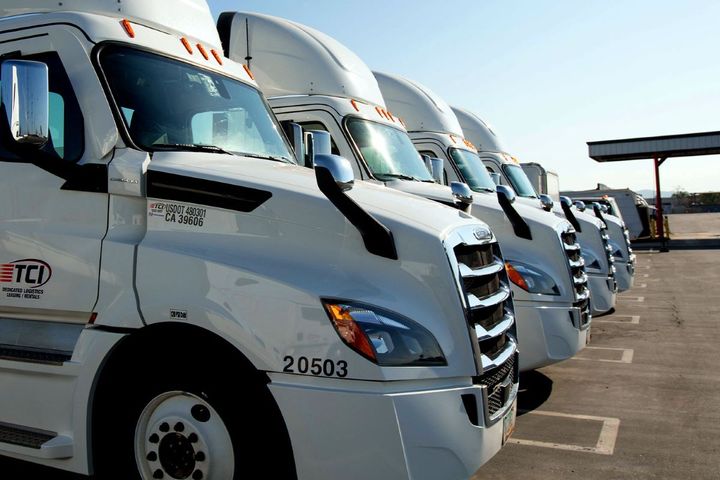
TCI Transportation’s strategy to improve overall fuel economy and freight efficiency is to add more electric trucks and tractors to its fleet.
Photo: TCI Transportation
TCI Transportation – Commerce, California
TCI Transportation is focused on adding more electric trucks and tractors to its fleet, as well as yard tractors. Out of 714 heavy-duty vehicles, 50 are currently natural gas. There are also 340 medium-duty, four of those electric. It currently has charging stations in its Fontana and Commerce locations and plans to install more to support the additional EVs it has on order: eight Freightliner eCascadia tractors, eight medium-duty electric Freightliner trucks, four Nikola fuel-cell tractors, and 50 Tesla Semi electric Class 8 tractors. It expects to receive all these by the end of 2023. Solar panels are being installed in the Commerce and Fontana locations.
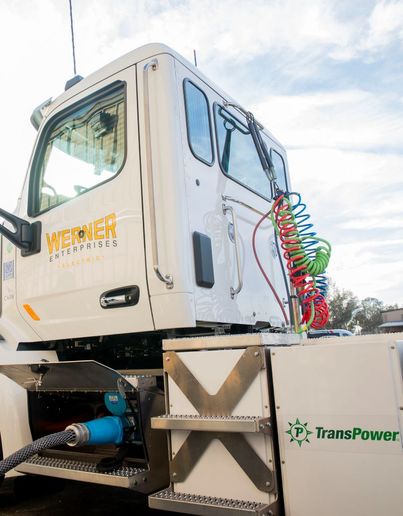
The WernerBlue Task Force, launched in April, works to consider current and emerging trends to drive Werner’s ESG strategies and priorities.
Photo: Werner Enterprises
Werner Enterprises – Omaha, Nebraska
Werner has a commitment to investing in and testing alternative fuels, equipment, and technology. The fleet of just over 8,000 heavy-duty vehicles has an average truck age of two years and trailer age of four years, for better fuel efficiency and lower emissions. More than 4,700 trucks have GHG II emissions engines. Werner is piloting solar panels to extend battery life. And it’s using solar-power GPS devices on new trailers instead of battery-powered. A new 90,000-square-foot facility in New England boasts a full array of solar panels on its roof, providing enough energy to supply an average of 10% of the energy for the building. The company has signed a letter of intent to buy 500 Cummins 15L hydrogen internal-combustion engines. Werner has a goal to reach a 55% reduction in greenhouse gas emissions by 2035.
This article was published as the cover story of the November/December 2022 issue of Heavy Duty Trucking.
-
AuthorPosts
- You must be logged in to reply to this topic.